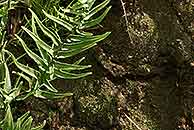Pellaea longipilosa Bonap.
Synonyms |
|
|---|---|
Common name |
|
Description |
Rhizome shortly creeping to sub-erect, up to 8 mm in diameter; rhizome scales, linear, subentire, 4-8 mm long, chestnut or dark brown with pale margins. Fronds monomorphic, tufted, erect, 20-45 cm tall, coriaceous. Stipe 5-20 cm long, brown to black, glabrous with age and with brown scales near the base similar to those on the rhizome. Lamina pinnate to 2-pinnate in the lower parts, narrowly oblong to lanceolate in outline, 8-39 × 2.5-12 cm, with up to 24 pairs of pinnae; pinnae narrowly ovate to linear in outline, slowly tapering to a somewhat rounded apex, cordate base articulated to a short petiole, 1-6.5 x 0.2-2.5 cm, hairless above, sparsely hairy or hairless below; veins hardly visible and free; rhachis and secondary rhachises brown to black, with a brown indumentum becoming glabrous with age. Sori marginal, continuous; indusium entire, membranous, continuous. |
Notes | Could be mistaken for P. dura or P. doniana. P. dura has anastomosing veins, a more slender stipe and less hairs on stipe and rhachis. P. doniana is never 2-pinnate. |
Derivation | longipilosa: with long hairs, referring to the indumentum on the upper side of the rhachis (Jacobsen 1983); misleading allusion to the short brown hairs along stipe and rhachis (Burrows 1990). |
Habitat | On granite, sandstone, shales and serpentines in rocky deciduous woodland. |
Distribution worldwide | See African distribution. |
Distribution in Africa |
Burundi, Dem. Republic of Congo, Ethiopia, Kenya, Malawi, Mozambique, Somalia, Sudan and South Sudan, Tanzania , Uganda, Zambia, Zimbabwe. |
Growth form |
Lithophytic, terrestrial. |
Literature |
|

